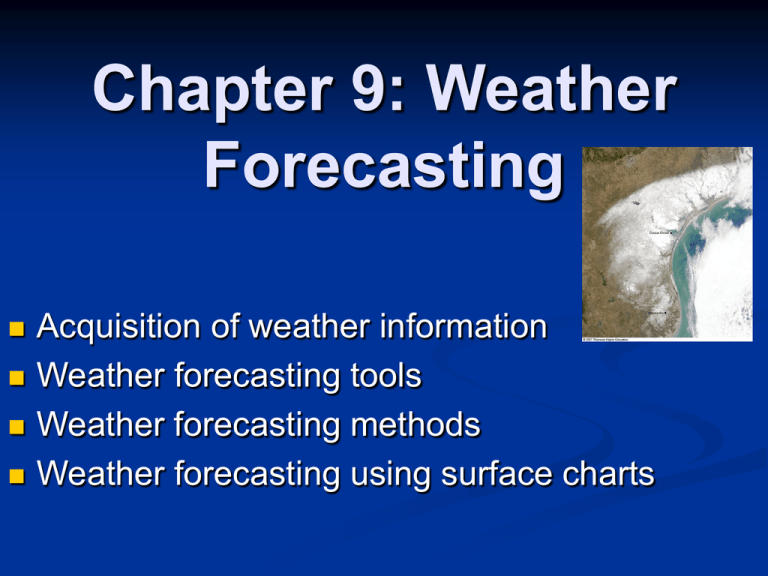Chapter 9 - Weather Underground
advertisement

Chapter 9: Weather Forecasting Acquisition of weather information Weather forecasting tools Weather forecasting methods Weather forecasting using surface charts Acquisition of Weather Information To make accurate forecasts, we need to know what the weather is right NOW A network of 10,000 land and sea based weather stations report data at least 4 times a day World Meteorological Organization (WMO) Responsible for keeping weather data from 175 nations in the same format Example : Baghdad History Acquisition of Weather Information Observations come to National Center for Environmental Prediction (NCEP) Analyze the data, then transmit to local public and private offices via the National Weather Service (NWS) All forecasters in the country use information provided by NCEP and NWS Watch - issued when hazardous weather is expected for a specific period of time Warning – indicates hazardous weather is imminent of occurring already Acquisition of Weather Information Advisory – to inform public is less hazardous conditions For example: High wind warning is issued when sustained winds are at least 40 mph of gusts have reaches 57 mph. Severe thunderstorm watches are issued thunderstorms with strong winds and large hail are possible Full list of watches and warnings on page 237. Weather Forecasting Tools Advanced Weather Interactive Processing System (AWIPS) Allows forecasters to put all tools in one program Can look at observations, radar, maps, etc. Meteogram – a charge that shows how variables change for a given time Sounding – two-dimensional vertical profile of temperature, dew point, and winds Weather Forecasting Tools Weather Forecasting Tools Satellites and Weather Forecasting Before satellites, tropical storms and hurricane went undetected. Now, they provide advanced warning Geostationary satellites – orbit at the same rate as the Earth is spinning. Example : Here Satellites and Weather Forecasting Polar orbiting satellites – parallel median lines and move from pole to pole Orbit at a lower altitude (greater detail) Can get the poles with no distortion Satellites and Weather Forecasting Geostationary operational environmental satellite (GOES) New generation satellite Can detect amount of radiation coming from clouds Can obtain info about moisture at different levels Infrared images – shows how much radiation clouds are emitting. (Diff between high and low clouds?) Visible images – Detect radiation that is reflected to satellite (like a photograph) Satellites and Weather Forecasting Fig. 9-9a, p. 242 Fig. 9-9b, p. 242 Fig. 9-10, p. 243 The Computer and Weather Forecasting: Numerical Weather Prediction Analysis – a final interpretation of a weather chart after human correction Numerical weather prediction – the use of computers to predict the weather using complex math Atmospheric models – mathematical models that create a picture of the current atmosphere Progs (prognostic chart) – a chart weather forecast for a time in the future • One of the world’s first computers was built for the specific purpose of performing weather forecasts. Why NWS Forecasts Go Awry and Steps to Improve Them Bad assumptions by a model (sometimes good and sometimes bad) Grid spacing varies for each model Chaos – small, unpredictable changes Ensemble forecasting Running multiple models to obtain a consensus Other Forecasting Methods Persistence forecast – forecast for tomorrow will be what happened today Trend forecast – atmos movements will remain the same in the future Analogue method – current patterns will provide similar weather to similar patterns in the past Statistical forecast – forecasts weighted and made by a computer Other Forecasting Methods Probability forecast – gives a percent change of something (what does 40% change of rain mean?) Climatological forecast – forecast based on climatology Other Forecasting Methods Types of Forecasts Very short range forecast – forecast for up to few hours (nowcast) Short range forecast – generally a forecast for up to a few days Medium range forecast – 3 to 8 days out Long range forecast – beyond 8 days out • Long-range forecasts are less specific than short range forecasts. Types of Forecasts Accuracy and Skill in Forecasting Forecasts of a few hours to a few days are good Forecast of a few days are better than “flipping a coin” Long range forecasts are generally very bad What is a bad forecast? Is a forecast off by a few degrees bad? If I say that it will not rain in the summer in San Jose, does that show skill? The skillful forecast would be to say when it WOULD rain in San Jose in the summer Accuracy and Skill in Forecasting Forecasts have gotten better over the past 15 years due to computer models 7-day forecast now are as skillful as 3-day forecast 10 years ago Forecasting thunderstorms and tornadoes are extremely difficult Predicting the Weather From Local Signs Book of Signs was written in 300 B.C. to try to predict the weather Used color and shape of clouds. Also intensity of which a fly bites Halo around the sun – a halo around the sun could mean rain is on the way. Halo made by bending light through cirrostratus Predicting the Weather From Local Signs Table 9-2, p. 254 Determining the Movement of Weather Systems Forecasting rules of thumb Storms are fronts tend to move in the same direction with the same speed as previous 6 hours Low pressure systems move parallel to isobars in warm air region Lows move where pressure drops fast, highs where pressure rises fast Systems move in same direction as wind in 500-mb level Determining the Movement of Weather Systems forecasting rules of thumb using the surface chart A Forecast for Six Cities Augusta, Georgia Washington, DC: rain or snow? Chicago: major snowstorm Memphis: mixed bag Dallas: cold wave Denver: clear and cold Stepped Art Fig. 9-21, p. 256











